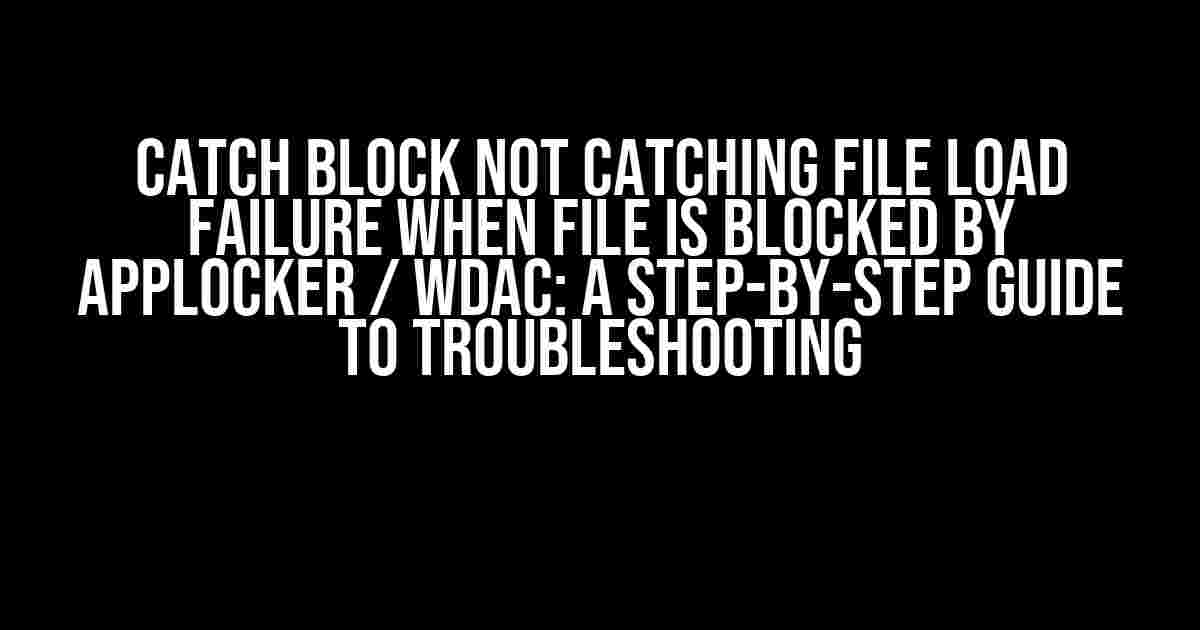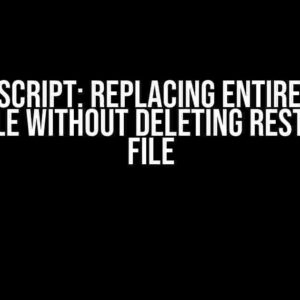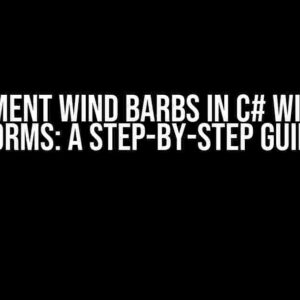Are you tired of scratching your head, wondering why your catch block isn’t catching file load failures when files are blocked by AppLocker or WDAC? You’re not alone! In this article, we’ll delve into the world of Windows application security and explore the reasons behind this frustrating issue. We’ll also provide you with clear, step-by-step instructions to troubleshoot and resolve the problem.
Understanding AppLocker and WDAC
Before we dive into the meat of the issue, it’s essential to understand what AppLocker and WDAC are and how they work.
AppLocker
AppLocker is a Windows feature that enables administrators to specify which applications are allowed to run on a device. It uses a set of rules to allow or deny access to files, registry keys, and other system resources. AppLocker is a powerful tool for controlling what applications can do on a Windows system.
WDAC
Windows Defender Application Control (WDAC) is a Windows 10 feature that provides an additional layer of security by blocking unauthorized applications from running on a device. WDAC uses a combination of AppLocker and other Windows security features to provide a robust defense against malware and other threats.
The Problem: Catch Block Not Catching File Load Failure
Now, let’s get to the heart of the issue. You’ve written a .NET application that tries to load a file, but the file is blocked by AppLocker or WDAC. You’ve wrapped your file load code in a try-catch block, expecting it to catch any exceptions that occur when the file can’t be loaded. However, to your surprise, the catch block isn’t catching the exception.
Here’s an example of what your code might look like:
try
{
using (FileStream fs = new FileStream(@"C:\blocked_file.exe", FileMode.Open))
{
// Do something with the file
}
}
catch (Exception ex)
{
Console.WriteLine("Caught exception: " + ex.Message);
}
In this example, you’d expect the catch block to catch the exception and print a message to the console. But, in this case, the catch block isn’t catching anything.
Why the Catch Block Isn’t Catching the Exception
So, why isn’t the catch block catching the exception? The answer lies in how AppLocker and WDAC work. When a file is blocked, Windows doesn’t throw an exception that can be caught by your .NET application. Instead, the file load operation simply fails, and your application doesn’t receive any notification.
This is because AppLocker and WDAC operate at a lower level than your .NET application. They intercept file load operations and block them before your application even gets a chance to try to load the file.
Troubleshooting Steps
Now that we understand the problem, let’s take a step-by-step approach to troubleshooting and resolving the issue.
Step 1: Verify That the File is Blocked by AppLocker or WDAC
First, make sure that the file is indeed blocked by AppLocker or WDAC. You can do this by:
- Checking the Windows Event Log for AppLocker or WDAC events related to the blocked file.
- Using the Windows Defender Advanced Threat Protection (ATP) console to check for blocked files.
- Running the
Get-AppLockerPolicyPowerShell cmdlet to retrieve the AppLocker policy and check for rules that might be blocking the file.
Step 2: Check the File Load Operation
Next, verify that the file load operation is failing due to the block. You can do this by:
- Using the Windows API Monitor tool to monitor the file load operation and check for errors.
- Checking the Windows Error Log for errors related to the file load operation.
- Running a debug build of your application to step through the code and inspect the file load operation.
Step 3: Implement an Alternative Solution
Since the catch block isn’t catching the exception, we need to implement an alternative solution to handle the file load failure. One approach is to use the File.Exists method to check if the file exists before trying to load it:
if (File.Exists(@"C:\blocked_file.exe"))
{
using (FileStream fs = new FileStream(@"C:\blocked_file.exe", FileMode.Open))
{
// Do something with the file
}
}
else
{
Console.WriteLine("File does not exist or is blocked");
}
This code checks if the file exists before trying to load it. If the file doesn’t exist or is blocked, the code prints a message to the console.
Conclusion
In this article, we’ve explored the issue of catch blocks not catching file load failures when files are blocked by AppLocker or WDAC. We’ve discussed the reasons behind this issue and provided step-by-step instructions for troubleshooting and resolving the problem.
By following these steps and implementing an alternative solution, you can ensure that your .NET application handles file load failures gracefully, even when files are blocked by AppLocker or WDAC.
| Best Practices | Description |
|---|---|
| Verify file existence before loading | Use the File.Exists method to check if the file exists before trying to load it. |
| Monitor file load operations | Use tools like Windows API Monitor or the Windows Error Log to monitor file load operations and detect errors. |
| Implement alternative solutions | Use alternative solutions like checking file existence or using other file load methods to handle file load failures. |
By following these best practices, you can ensure that your .NET application is robust and reliable, even in the face of file load failures due to AppLocker or WDAC blocks.
Frequently Asked Question
Get the answers to the most frequently asked questions about catch blocks not catching file load failures when files are blocked by AppLocker or WDAC.
Why does the catch block not catch file load failures when files are blocked by AppLocker or WDAC?
This is because AppLocker and WDAC operate at a lower level than the .NET runtime, so the file load failure is not propagated as a .NET exception. Instead, the operating system prevents the file from being loaded, and the .NET runtime is not aware of the failure.
How can I detect file load failures caused by AppLocker or WDAC?
You can use the Windows API function GetProcAddress to check if the file has been successfully loaded. If the function returns NULL, it indicates that the file load failed.
Can I use a try-catch block to catch file load failures caused by AppLocker or WDAC?
No, a try-catch block will not catch file load failures caused by AppLocker or WDAC, as these failures are not propagated as .NET exceptions. You need to use a different approach, such as using the Windows API function GetProcAddress, to detect these failures.
How can I handle file load failures caused by AppLocker or WDAC in my application?
You can handle file load failures caused by AppLocker or WDAC by using a combination of error handling mechanisms, such as checking the return value of the Windows API function GetProcAddress, and implementing alternative logic to handle the failure. For example, you can try to load a fallback assembly or use a alternative implementation.
Are there any workarounds to make AppLocker or WDAC exceptions propagatable as .NET exceptions?
No, there are no workarounds to make AppLocker or WDAC exceptions propagatable as .NET exceptions. The .NET runtime is not aware of the file load failure caused by AppLocker or WDAC, and therefore, cannot propagate it as an exception.





